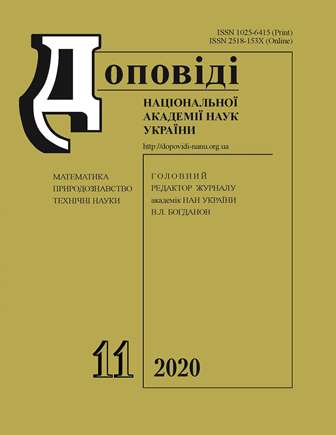Water purification from heavy metal ions by nano-sized Fe0/kaolinite composites
DOI:
https://doi.org/10.15407/dopovidi2020.11.096Keywords:
composite silicate sorbents, heavy metals, nanoscale zero-valent iron, water treatmentAbstract
We have investigated the physicochemical features of the purification of wastewater that are complex on its content and include a mixture of heavy metal ions (Cu(II), Cd(II), Zn(II), Co(II), Cr(VI)). The phase of a composition and structural-sorption characteristics of synthesized nano-sized Fe0/kaolinite composites were studied. It was found that the obtained materials have much better sorption properties for the extraction of heavy metals from aqueous solutions in comparison with natural kaolinite. Calculations of sorption isotherms according to the Freundlich equation are done. Based on isotherms, the average values of specific sorption per unit of an active surface of the mineral at the content of heavy metal ions in the initial solutions of 300 μmol/dm3 were determined. They range from 0.42 to 17.1 μmol/g for Cr(VI) to Cu(II) ions. It has also been found that similar values for the modified samples are much larger and range from 13.8 to 80.27 μmol/g for ions from Cr(VI) to Cu(II). It is shown that composite sorbents based on nano-sized zero-valent iron and dispersed kaolinite silicate are effective sorbent materials for the purification of water contaminated with toxic heavy metal ions that are commonly found in wastewater of the galvanic and hydrometallurgical industries.
Downloads
References
Vareda, J. P., Valente, A. & Duraes, L. (2019). Assessment of heavy metal pollution from anthropogenic activities and remediation strategies: A review. J. Environ. Manag., 246, pp. 101-118. https://doi.org/10.1016/j.jenvman.2019.05.126
Kurniawan, T. A., Chan, G. Y., Lo, W. H. & Babel, S. (2006). Comparisons of low-cost adsorbents for treating wastewaters laden with heavy metals. Sci. Total Environ., 366, pp. 409-426. https://doi.org/10.1016/j.scitotenv.2005.10.001
Jawed, A., Saxena, V. & Pandey, L. M. (2020). Engineered nanomaterials and their surface functionalization for the removal of heavy metals: A review. J. Water Process Eng., 33, 101009. https://doi.org/10.1016/j.jwpe.2019.101009
Fu, F., Dionysiou, D. D. & Liu, H. (2014). The use of zero-valent iron for groundwater remediation and wastewater treatment: a review. J. Hazard. Mater., 267, pp. 194-205. https://doi.org/10.1016/j.jhazmat.2013.12.062
Trujillo-Reyes, J., Peralta-Videa, J. R. & Gardea-Torresdey, J. L. (2014). Supported and unsupported nanomaterials for water and soil remediation: are they a useful solution for worldwide pollution? J. Hazard. Mater., 280, pp. 487-503. https://doi.org/10.1016/j.jhazmat.2014.08.029
Zou, Y., Wang, X., Khan, A., Wang, P., Liu, Y., Alsaedi, A., Hayat T. & Wang, X. (2016). Environmental remediation and application of nanoscale zero-valent iron and its composites for the removal of heavy metal ions: a review. Environ. Sci. Technol., 50, pp. 7290-7304. https://doi.org/10.1021/acs.est.6b01897
Bhattacharyya, K. G. & Gupta, S. S. (2008). Adsorption of a few heavy metals on natural and modified kaolinite and montmorillonite: a review. Adv. Colloid Interface Sci., 140, pp. 114-131. https://doi.org/10.1016/j.cis.2007.12.008
Yavuz, Ö., Altunkaynak, Y. & Güzel, F. (2003). Removal of copper, nickel, cobalt and manganese from aqueous solution by kaolinite. Water Res., 37, pp. 948-952. https://doi.org/10.1016/S0043-1354(02)00409-8
Üzüm, Ç., Shahwan, T., Eroğlu, A. E., Hallam, K. R., Scott, T. B. & Lieberwirth, I. (2009). Synthesis and characterization of kaolinite-supported zero-valent iron nanoparticles and their application for the removal of aqueous Cu2+ and Co2+ ions. Appl. Clay Sci., 43, pp. 172-181. https://doi.org/10.1016/j.clay.2008.07.030
Zhang, X., Lin, S., Lu, X. Q. & Chen, Z. L. (2010). Removal of Pb (II) from water using synthesized kaolin supported nanoscale zero-valent iron. Chem. Eng. J., 163, pp. 243-248. https://doi.org/10.1016/j.cej.2010.07.056
Genç-Fuhrman, H., Mikkelsen, P. S. & Ledin, A. (2016). Simultaneous removal of As, Cd, Cr, Cu, Ni and Zn from stormwater using high-efficiency industrial sorbents: Effect of pH, contact time and humic acid. Sci. Total Environ., 566, pp. 76-85. https://doi.org/10.1016/j.scitotenv.2016.04.210
Ovcharenko, F. D. (Ed.). (1982). Kaolin of Ukraine: reference book. Kyiv: Naukova Dumka (in Russian).
Tobilko, V. Yu. & Kornilovych, B. Yu. (2015). Synthesis and sorption properties of composite materials based on nanoscale Fe0. Vostochno-Evropeyskiy zhurnal peredovyih tehnologiy, No. 4/5, pp. 22-27 (in Ukrainian). https://doi.org/10.15587/1729-4061.2015.46580
Karnaukhov, A. P. (1999). Adsorption: Texture of disperse and porous materials. Novosibirsk: Nauka (in Russian).
Langmuir, D. (1997). Aqueous environmental geochemistry. Upper Saddle River, NJ: Prentice Hall.
Downloads
Published
How to Cite
Issue
Section
License
Copyright (c) 2023 Reports of the National Academy of Sciences of Ukraine

This work is licensed under a Creative Commons Attribution-NonCommercial 4.0 International License.




